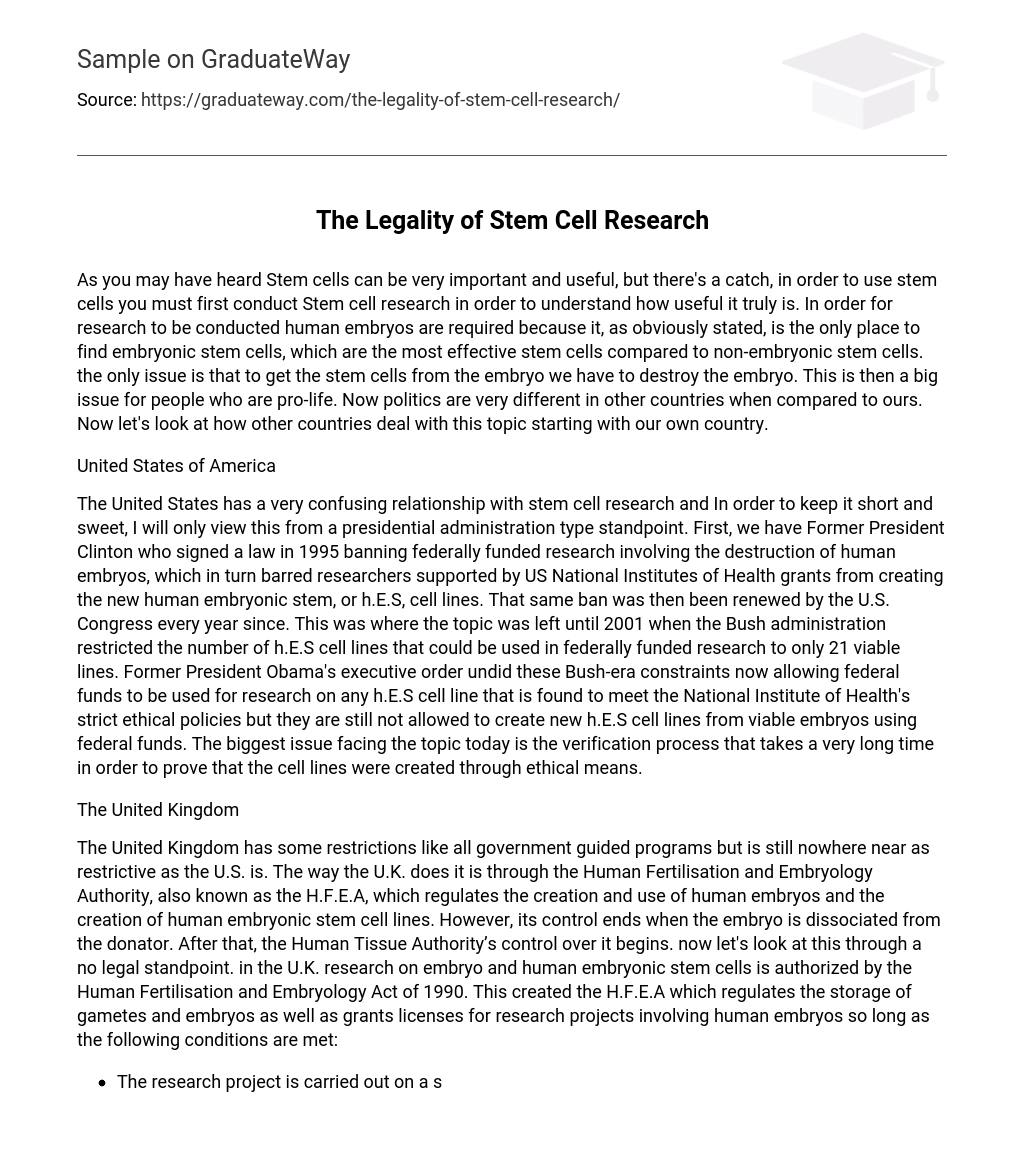As you may have heard Stem cells can be very important and useful, but there’s a catch, in order to use stem cells you must first conduct Stem cell research in order to understand how useful it truly is. In order for research to be conducted human embryos are required because it, as obviously stated, is the only place to find embryonic stem cells, which are the most effective stem cells compared to non-embryonic stem cells. the only issue is that to get the stem cells from the embryo we have to destroy the embryo. This is then a big issue for people who are pro-life. Now politics are very different in other countries when compared to ours. Now let’s look at how other countries deal with this topic starting with our own country.
United States of America
The United States has a very confusing relationship with stem cell research and In order to keep it short and sweet, I will only view this from a presidential administration type standpoint. First, we have Former President Clinton who signed a law in 1995 banning federally funded research involving the destruction of human embryos, which in turn barred researchers supported by US National Institutes of Health grants from creating the new human embryonic stem, or h.E.S, cell lines. That same ban was then been renewed by the U.S. Congress every year since. This was where the topic was left until 2001 when the Bush administration restricted the number of h.E.S cell lines that could be used in federally funded research to only 21 viable lines. Former President Obama’s executive order undid these Bush-era constraints now allowing federal funds to be used for research on any h.E.S cell line that is found to meet the National Institute of Health’s strict ethical policies but they are still not allowed to create new h.E.S cell lines from viable embryos using federal funds. The biggest issue facing the topic today is the verification process that takes a very long time in order to prove that the cell lines were created through ethical means.
The United Kingdom
The United Kingdom has some restrictions like all government guided programs but is still nowhere near as restrictive as the U.S. is. The way the U.K. does it is through the Human Fertilisation and Embryology Authority, also known as the H.F.E.A, which regulates the creation and use of human embryos and the creation of human embryonic stem cell lines. However, its control ends when the embryo is dissociated from the donator. After that, the Human Tissue Authority’s control over it begins. now let’s look at this through a no legal standpoint. in the U.K. research on embryo and human embryonic stem cells is authorized by the Human Fertilisation and Embryology Act of 1990. This created the H.F.E.A which regulates the storage of gametes and embryos as well as grants licenses for research projects involving human embryos so long as the following conditions are met:
- The research project is carried out on a suitable premises
- The use of human embryos is required for the study\research
- It helps increase knowledge of serious diseases or other serious conditions.
- It helps develop treatments for serious diseases or other serious medical conditions.
- It helps Increase knowledge about the causes of congenital diseases.
- It helps promote advances in the treatment of infertility.
- It helps increase the knowledge about the causes of miscarriages.
- It helps develop more efficient techniques of contraception.
- It helps develop methods for detecting gene, chromosome or mitochondrial abnormalities in embryos before implantation.
- It helps increase knowledge about the development of embryos.
- The consent of the people donating their eggs, sperm or embryos for research is provided
- The embryos must not be allowed to develop in the laboratory beyond 14 days after fertilization
- No embryo that is created or used in research can be transferred to a woman
When a new human embryonic stem cell line is fully characterized and cultured in order to guarantee uniform characteristics it is a condition of all Human Fertilisation and Embryology Authority research licenses that the cell line is deposited in the UK Stem Cell Bank.
The majority of embryos used in research projects were donated by patients undergoing fertility treatment although some embryos can also be created for research purposes through sperm and eggs donated either by people undergoing fertility treatment or non-patient donors who wish to support a research project involving the creation of embryos for a study.
Switzerland
The last country we will take a look at is Switzerland which is a lot like the U.K. in the way it does things but did not start the programs until 2003-2005. Once again we will look at this from a more legal standpoint. So the way Switzerland controls Stem cell research is through the Federal Act on Research Involving Embryonic Stem Cells of 19 December 2003. This act allows unused\surplus IVF, in vitro fertilization, embryos to be used in research under strict licensing conditions and with the consent of the couple who donated them. Surplus embryos can only be kept for research purposes and are not allowed to freeze embryos for further IVF treatment or donation. All embryos used in research must be destroyed following their use. The same act also allows for the importation of embryonic stem cells for research purposes but also lists the criminal penalties for failure to comply with the conditions for research on embryos.





